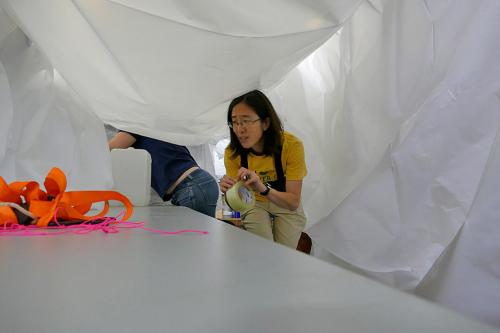GO DEEPER DISCUSSION: (see previous journal for the questions.)
The US Coast Guard Base in Seattle is just a few blocks away from two major sports stadiums- Safeco Field and Century Link Field. The Seattle Mariners (Major League Baseball) play in Safeco Field. Century Link Field is home to the Seattle Seahawks (National Football League) and Seattle Sounders (Major League Soccer.)
TODAY'S JOURNAL:
Previously, I discussed gear loading and aerosol sampler set-up in preparations for the upcoming 2015 US Arctic GEOTRACES cruise. Today, I’d like to show you another important part of the preparations- setting up a clean lab space called The Bubble.
The US Coast Guard Cutter Healy was designed to support science expeditions in polar oceans. Among the many features Healy boasts to support scientific endeavors is a 1,233 square-foot main lab. This spacious area is located immediately forward of the aft working deck (aka fantail deck) and can be customized depending on the type of lab setups needed. On our cruise, several of the teams aboard require a very clean space in which to do their detailed measurements and analysis of trace elements. To accomplish this, they rigged up an enclosed plastic bubble to house their working areas, providing a clean room within the larger lab. The bubble is made from wide, heavy duty white plastic sheeting that is first hung from a framework of strings and taped to the lab’s existing science bench frames. Successive sheets are stitched together with packing tape, first forming a ceiling and then with walls hanging down behind the lab benches and on each end of the aisle where it hangs.
 Dr. Phoebe Lam, armed with packing tape, works on bubble construction in the USCGC Healy’s Main Science Lab.
Dr. Phoebe Lam, armed with packing tape, works on bubble construction in the USCGC Healy’s Main Science Lab.
 PolarTREC Teacher Bill Schmoker providing backing support for packing tape being applied to a seam inside the bubble.
PolarTREC Teacher Bill Schmoker providing backing support for packing tape being applied to a seam inside the bubble.
At the bottom of the bubble walls, thin lengths of lumber called furring strips are rolled into the plastic and stapled in place. Their weight holds the walls down and provides rigidity to help keep the bubble ship-shape.
 Dr. Chris Marsay rolling a pine furring strip into the bottom of the bubble wall and stapling it in place to provide weight and rigidity for the bubble’s base.
Dr. Chris Marsay rolling a pine furring strip into the bottom of the bubble wall and stapling it in place to provide weight and rigidity for the bubble’s base.
Meanwhile, special fan/filter units called Mac 10s are suspended from the grid work above the lab benches. After the ceiling plastic is in place the bubble builders cut openings for the Mac 10 filters and sealed them in place with more packing tape. These units provide fresh air for the bubble that has been filtered to HEPA standards. HEPA stands for High-Efficiency Particulate Arrestance. To qualify as HEPA by US government standards, an air filter must remove 99.97% of particles that have a size of at least 0.3 microns, or 3/10 of a millionth of a meter. Beyond filtering the air, the five Mac 10s in the bubble ceiling provide positive pressure which inflates the bubble, making the walls firm and the ceiling arched up instead of just a bunch of slack plastic draped around the lab.
 Dr. Neil Wyatt contemplates lab space and stowed gear in his corner of the bubble.
Dr. Neil Wyatt contemplates lab space and stowed gear in his corner of the bubble.
When we rendezvous with the Healy in Dutch Harbor, all surfaces inside the bubble will get thoroughly wiped down, stored gear will be unpacked or moved out of the bubble, and additional plastic sheeting will be used to cover any remaining areas that can use it. Finally, Scientists will set up their lab equipment in their allotted spaces within the clean bubble for the cruise and away we’ll go!
Stay tuned for more about the work in the bubble on the cruise!
GO DEEPER!
The bubble walls aren’t taped to the floor, and it doesn’t need a tightly closed door (just a loose flap of plastic is used.) It doesn’t even need to have every centimeter of seam or small holes patched to still work effectively. Can you explain why?
That's all for now. Best- Bill


Comments